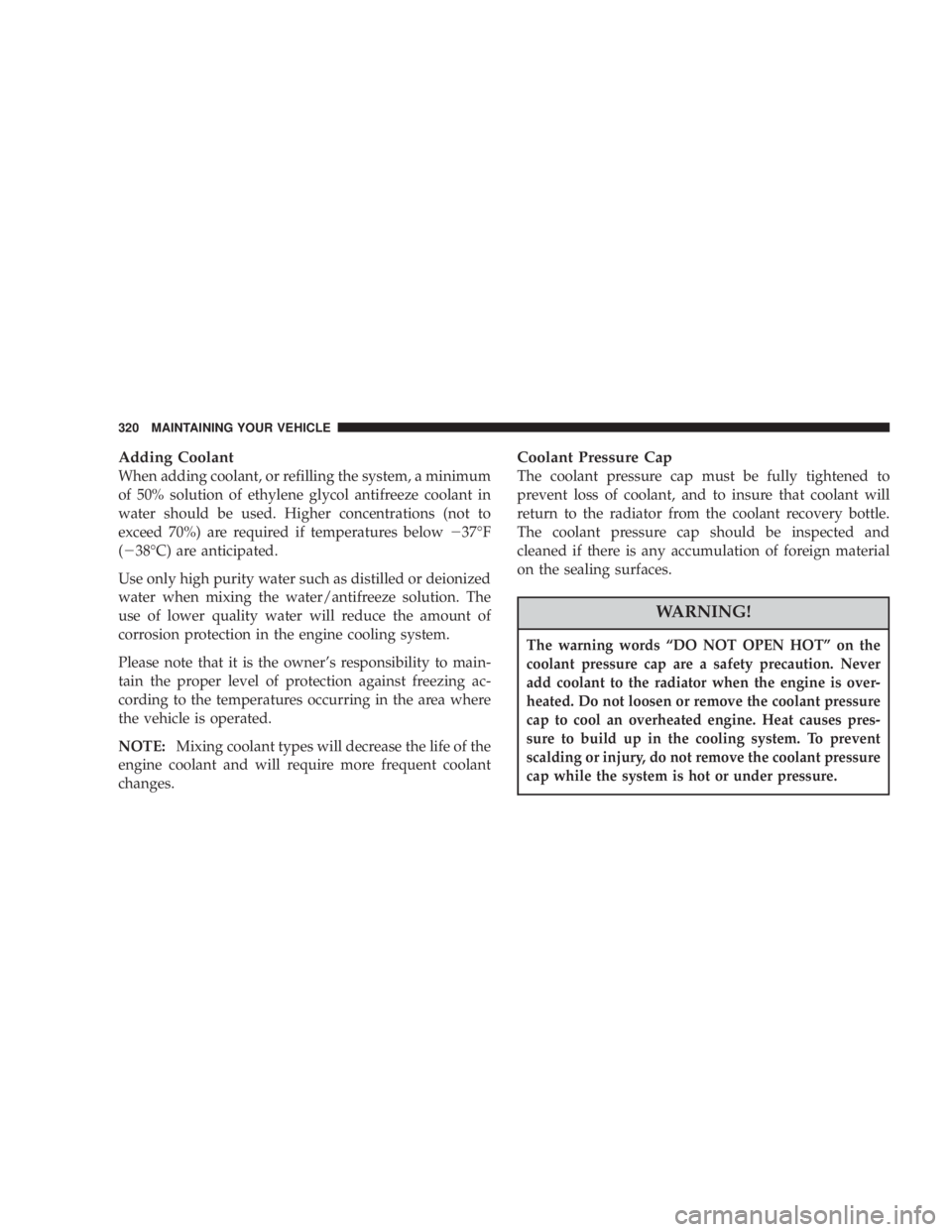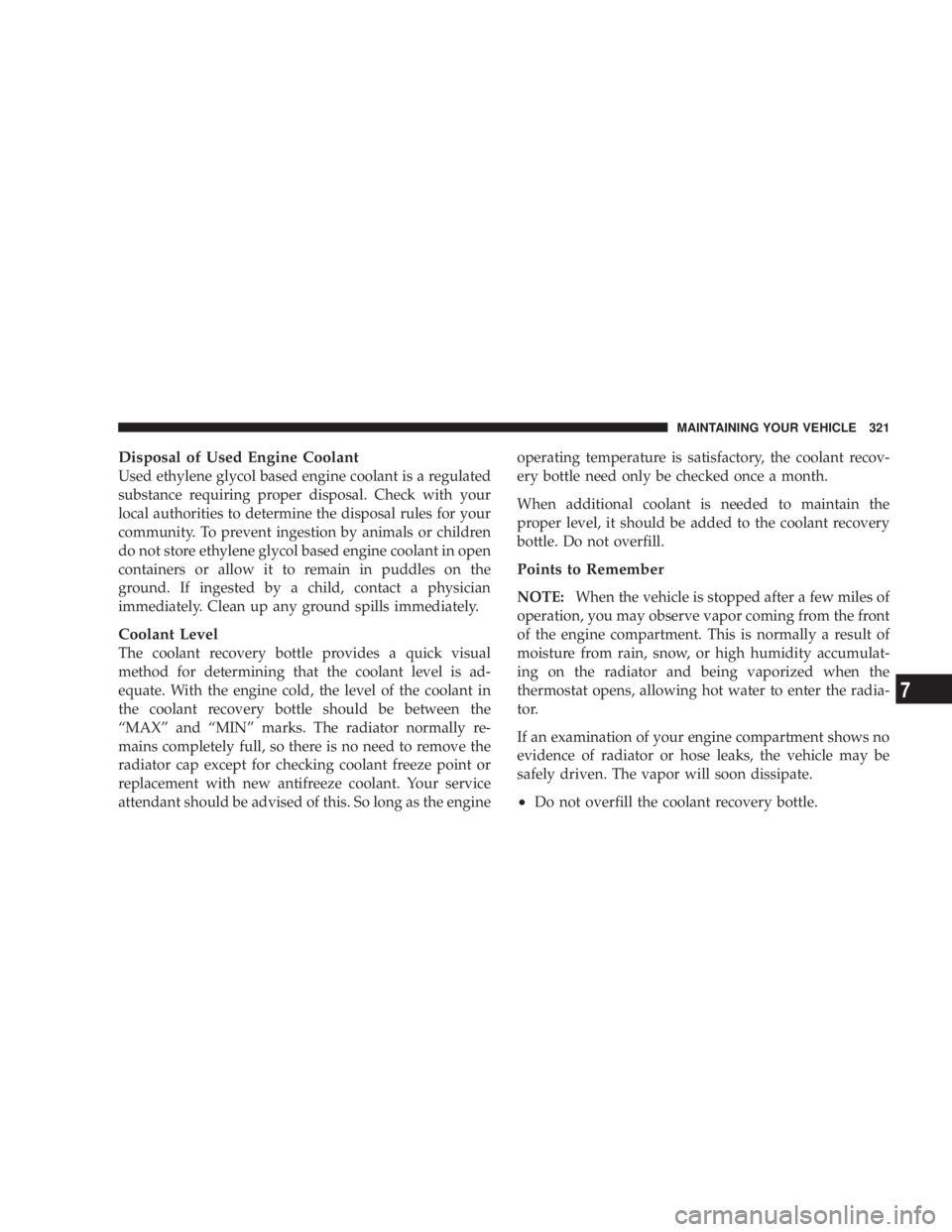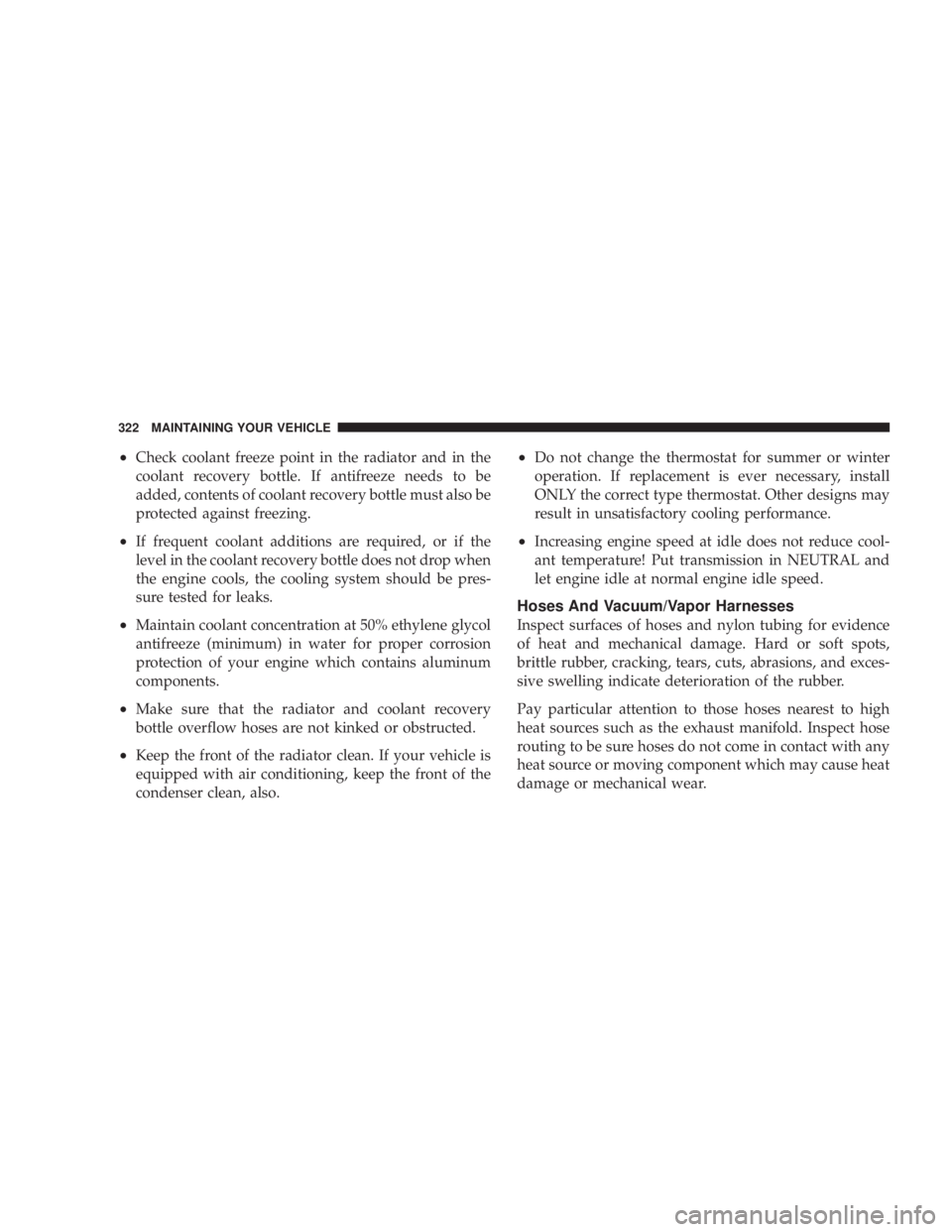2004 DODGE GRAND CARAVAN coolant temperature
[x] Cancel search: coolant temperaturePage 154 of 397

12. Engine Temperature Warning Light
This light warns of an overheated engine condi-
tion. If the engine is critically hot, a continuous
chime will sound for 4 minutes. After the chime
turns off, the engine will still be critically hot until the
light turns off.
13. Vehicle Theft Alarm Light Ð If Equipped
This light will flash for approximately 15 sec-
onds when the vehicle theft alarm is arming.
14. Temperature Gauge
The temperature gauge shows engine coolant tempera-
ture. Any reading within the normal range indicates that
the engine cooling system is operating satisfactorily. The gauge pointer will likely indicate a higher tempera-
ture when driving in hot weather, up mountain grades,
or when towing a trailer. It should not be allowed to
exceed the upper limits of the normal operating range.
CAUTION!Driving with a hot engine cooling system could
damage your vehicle. If temperature gauge reads (H),
pull over and stop the vehicle. Idle the vehicle with
the air conditioner turned off until the pointer drops
back into the normal range. If the pointer remains on
the ªHº, and you hear continuous chimes, turn the
engine off immediately, and call for service.154 UNDERSTANDING YOUR INSTRUMENT PANEL
Page 217 of 397

Bi-Level Mode
Air comes from both the headliner outlets and the
floor outlets.
NOTE: In many temperature positions, the bi-level
mode is designed to provide cooler air out of the head-
liner outlets and warmer air from the floor outlets.
Headliner Mode
Air comes from the outlets in the headliner. Each of
these outlets can be individually adjusted to direct
the flow of air. Moving the air vane knob on the outlets to
one side will shut off the air flow.
Summer Operation
The engine cooling system in air conditioned vehicles
must be protected with a high-quality antifreeze coolant
to provide proper corrosion protection and to protect
against engine overheating. A 50% solution of ethylene glycol antifreeze coolant in water is recommended. Refer
to section 7, Maintenance Procedures, of this manual for
proper coolant selection.
Winter Operation
The air from the heater system will heat faster in cold
weather if you use only low blower speeds for the first 10
minutes of vehicle operation. Use of the air Recirculation
mode during winter months is not recommended be-
cause it may cause window fogging.
Vacation Storage
Anytime you store your vehicle, or keep it out of service
(i.e. vacation) for two weeks or more, run the air condi-
tioning system at idle for about five minutes in the fresh
air and high blower setting. This will insure adequate
system lubrication to minimize the possibility of com-
pressor damage when the system is started again. UNDERSTANDING YOUR INSTRUMENT PANEL 217
4
Page 318 of 397

Cooling System
Inspection
WARNING!² When working near the radiator cooling fan, turn
the ignition key to the OFF position. The fan is
temperature controlled and can start at any time
when the ignition key is in the ON position.
² You or others can be badly burned by hot coolant
or steam from your radiator. If you see or hear
steam coming from under the hood, don't open
the hood until the radiator has had time to cool.
Never try to open a cooling system pressure cap
when the radiator is hot. Coolant Checks
Coolant protection checks should be made every 12
months (prior to the onset of freezing weather, where
applicable). If coolant is dirty or rusty in appearance, the
system should be drained, flushed and refilled with fresh
coolant. Check the front of the A/C condenser for any
accumulation of bugs, leaves, etc. If dirty, clean by
removing the upper grill support and gently spraying
water from a garden hose vertically down the face of the
condenser.
Check the coolant recovery bottle tubing for brittle rub-
ber, cracking, tears, cuts and tightness of the connection
at the bottle and radiator. Inspect the entire system for
leaks.
With the engine at normal operating temperature (but
not running), check the coolant pressure cap for proper
vacuum sealing by draining a small amount of coolant318 MAINTAINING YOUR VEHICLE
Page 320 of 397

Adding Coolant
When adding coolant, or refilling the system, a minimum
of 50% solution of ethylene glycol antifreeze coolant in
water should be used. Higher concentrations (not to
exceed 70%) are required if temperatures below 2 37ÉF
( 2 38ÉC) are anticipated.
Use only high purity water such as distilled or deionized
water when mixing the water/antifreeze solution. The
use of lower quality water will reduce the amount of
corrosion protection in the engine cooling system.
Please note that it is the owner's responsibility to main-
tain the proper level of protection against freezing ac-
cording to the temperatures occurring in the area where
the vehicle is operated.
NOTE: Mixing coolant types will decrease the life of the
engine coolant and will require more frequent coolant
changes. Coolant Pressure Cap
The coolant pressure cap must be fully tightened to
prevent loss of coolant, and to insure that coolant will
return to the radiator from the coolant recovery bottle.
The coolant pressure cap should be inspected and
cleaned if there is any accumulation of foreign material
on the sealing surfaces.
WARNING!The warning words ªDO NOT OPEN HOTº on the
coolant pressure cap are a safety precaution. Never
add coolant to the radiator when the engine is over-
heated. Do not loosen or remove the coolant pressure
cap to cool an overheated engine. Heat causes pres-
sure to build up in the cooling system. To prevent
scalding or injury, do not remove the coolant pressure
cap while the system is hot or under pressure.320 MAINTAINING YOUR VEHICLE
Page 321 of 397

Disposal of Used Engine Coolant
Used ethylene glycol based engine coolant is a regulated
substance requiring proper disposal. Check with your
local authorities to determine the disposal rules for your
community. To prevent ingestion by animals or children
do not store ethylene glycol based engine coolant in open
containers or allow it to remain in puddles on the
ground. If ingested by a child, contact a physician
immediately. Clean up any ground spills immediately.
Coolant Level
The coolant recovery bottle provides a quick visual
method for determining that the coolant level is ad-
equate. With the engine cold, the level of the coolant in
the coolant recovery bottle should be between the
ªMAXº and ªMINº marks. The radiator normally re-
mains completely full, so there is no need to remove the
radiator cap except for checking coolant freeze point or
replacement with new antifreeze coolant. Your service
attendant should be advised of this. So long as the engine operating temperature is satisfactory, the coolant recov-
ery bottle need only be checked once a month.
When additional coolant is needed to maintain the
proper level, it should be added to the coolant recovery
bottle. Do not overfill.
Points to Remember
NOTE: When the vehicle is stopped after a few miles of
operation, you may observe vapor coming from the front
of the engine compartment. This is normally a result of
moisture from rain, snow, or high humidity accumulat-
ing on the radiator and being vaporized when the
thermostat opens, allowing hot water to enter the radia-
tor.
If an examination of your engine compartment shows no
evidence of radiator or hose leaks, the vehicle may be
safely driven. The vapor will soon dissipate.
² Do not overfill the coolant recovery bottle. MAINTAINING YOUR VEHICLE 321
7
Page 322 of 397

² Check coolant freeze point in the radiator and in the
coolant recovery bottle. If antifreeze needs to be
added, contents of coolant recovery bottle must also be
protected against freezing.
² If frequent coolant additions are required, or if the
level in the coolant recovery bottle does not drop when
the engine cools, the cooling system should be pres-
sure tested for leaks.
² Maintain coolant concentration at 50% ethylene glycol
antifreeze (minimum) in water for proper corrosion
protection of your engine which contains aluminum
components.
² Make sure that the radiator and coolant recovery
bottle overflow hoses are not kinked or obstructed.
² Keep the front of the radiator clean. If your vehicle is
equipped with air conditioning, keep the front of the
condenser clean, also. ² Do not change the thermostat for summer or winter
operation. If replacement is ever necessary, install
ONLY the correct type thermostat. Other designs may
result in unsatisfactory cooling performance.
² Increasing engine speed at idle does not reduce cool-
ant temperature! Put transmission in NEUTRAL and
let engine idle at normal engine idle speed.
Hoses And Vacuum/Vapor Harnesses
Inspect surfaces of hoses and nylon tubing for evidence
of heat and mechanical damage. Hard or soft spots,
brittle rubber, cracking, tears, cuts, abrasions, and exces-
sive swelling indicate deterioration of the rubber.
Pay particular attention to those hoses nearest to high
heat sources such as the exhaust manifold. Inspect hose
routing to be sure hoses do not come in contact with any
heat source or moving component which may cause heat
damage or mechanical wear.322 MAINTAINING YOUR VEHICLE
Page 382 of 397

Adding Fuel ........................... 270
Adding Washer Fluid .................. 221,316
Additives, Fuel ......................... 268
Adjustable Pedals ....................... 106
Air Conditioner Maintenance ............... 312
Air Conditioning ..................... 199,203
Air Conditioning Controls ................. 199
Air Conditioning Filter ................. 219,313
Air Conditioning, Operating Tips ............ 218
Air Conditioning, Rear Zone ............. 206,214
Air Conditioning Refrigerant ............... 312
Air Conditioning System .......... 199,203,208,312
Air Conditioning System, Zone Control ........ 200
Air Pressure, Tires ....................... 252
Airbag ................................ 48
Airbag Deployment ....................... 55
Airbag Light ..................... 52,57,72,152
Airbag Maintenance ....................... 57
Airbag, Side ............................ 54 Alarm Light ........................... 154
Alarm System ........................... 26
Alignment and Balance ................... 258
All Wheel Drive ................... 235,259,329
Alterations/Modifications, Vehicle ............. 7
Antifreeze Disposal ...................... 321
Antifreeze (Engine Coolant) .............. 319,320
Anti-Lock Brake System ................... 237
Anti-Lock Warning Light .................. 153
Anti-Theft Security Alarm .................. 26
Appearance Care ........................ 330
Ashtray ............................... 130
Auto Down Power Windows ................ 37
Automatic Dimming Mirror ................. 77
Automatic Door Locks ..................... 19
Automatic Headlights .................... 100
Automatic Temperature Control ............. 208
Automatic Transaxle ................... 231,326
Adding Fluid ......................... 345382 INDEX
Page 386 of 397

Air Cleaner Filter ...................... 308
Block Heater ......................... 230
Break-In Recommendations ................ 70
Checking Oil Level ..................... 303
Compartment ...................... 298,299
Coolant ............................. 344
Cooling ............................. 318
Exhaust Gas Caution .................. 36,269
Fails to Start ....................... 227,229
Fuel Requirements ..................... 266
Oil .............................. 303,344
Oil Change Interval .................... 305
Oil Selection .......................... 305
Oil Synthetic ......................... 307
Overheating .......................... 281
Temperature Gauge ..................... 154
Exhaust Gas Caution .............. 36,71,269,317
Exhaust System ......................... 317
Exterior Folding Mirrors ................... 78 Filters
Air Cleaner .......................... 308
Air Conditioning .................... 219,313
Automatic Transaxle .................... 328
Engine Fuel .......................... 309
Engine Oil ........................ 307,344
Engine Oil Disposal .................... 307
Flashers
Hazard Warning ....................... 280
Turn Signal .................. 158,159,340,342
Fluid Capacities ......................... 343
Fluid Leaks ............................. 72
Fluid Level Checks
Automatic Transaxle .................... 327
Brake ............................... 345
Power Steering ..................... 314,345
Fog Light Service ........................ 341
Fog Lights .......................... 102,341
Freeing A Stuck Vehicle ................... 291386 INDEX